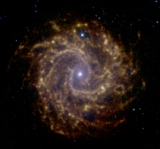
NGC 3184
Encyclopedia
NGC 3184 is a spiral galaxy
approximately 40 million light-year
s away in the constellation
Ursa Major
. It has two HII regions named NGC 3180 and NGC 3181.
NGC 3184 is notable for its high abundance of heavy elements and (SN 1999gi) that was a magnitude
14 Type II supernova
detected on December 9, 1999. Other supernovae in NGC 3184 include 1921B (mag 13.5), 1921C (mag 11) and 1937F (mag 13.5).
17 optical transient 33" east and 61" north of the center of NGC 3184 at coordinates 10 18 19.89 +41 26 28.8. This event may be an outbursting Luminous blue variable
(LBV) star. Archival Hubble
and Spitzer
images of NGC 3184 seem to show no progenitor for optical transient SN 2010dn. SN 2010dn is just like SN 2008S and NGC 300-OT. On day 2, SN 2010dn had an unfiltered magnitude of 17.1, corresponding to a peak absolute magnitude
of roughly -13.3.
Spiral galaxy
A spiral galaxy is a certain kind of galaxy originally described by Edwin Hubble in his 1936 work The Realm of the Nebulae and, as such, forms part of the Hubble sequence. Spiral galaxies consist of a flat, rotating disk containing stars, gas and dust, and a central concentration of stars known as...
approximately 40 million light-year
Light-year
A light-year, also light year or lightyear is a unit of length, equal to just under 10 trillion kilometres...
s away in the constellation
Constellation
In modern astronomy, a constellation is an internationally defined area of the celestial sphere. These areas are grouped around asterisms, patterns formed by prominent stars within apparent proximity to one another on Earth's night sky....
Ursa Major
Ursa Major
Ursa Major , also known as the Great Bear, is a constellation visible throughout the year in most of the northern hemisphere. It can best be seen in April...
. It has two HII regions named NGC 3180 and NGC 3181.
NGC 3184 is notable for its high abundance of heavy elements and (SN 1999gi) that was a magnitude
Apparent magnitude
The apparent magnitude of a celestial body is a measure of its brightness as seen by an observer on Earth, adjusted to the value it would have in the absence of the atmosphere...
14 Type II supernova
Type II supernova
A Type II supernova results from the rapid collapse and violent explosion of a massive star. A star must have at least 9 times, and no more than 40–50 times the mass of the Sun for this type of explosion. It is distinguished from other types of supernova by the presence of hydrogen in its spectrum...
detected on December 9, 1999. Other supernovae in NGC 3184 include 1921B (mag 13.5), 1921C (mag 11) and 1937F (mag 13.5).
SN 2010dn
On May 31, 2010, Koichi Itagaki detected a magnitudeApparent magnitude
The apparent magnitude of a celestial body is a measure of its brightness as seen by an observer on Earth, adjusted to the value it would have in the absence of the atmosphere...
17 optical transient 33" east and 61" north of the center of NGC 3184 at coordinates 10 18 19.89 +41 26 28.8. This event may be an outbursting Luminous blue variable
Luminous blue variable
Luminous blue variables, also known as S Doradus variables, are very bright, blue, hypergiant variable stars named after S Doradus, the brightest star of the Large Magellanic Cloud. They exhibit long, slow changes in brightness, punctuated by occasional outbursts in brightness during substantial...
(LBV) star. Archival Hubble
Hubble Space Telescope
The Hubble Space Telescope is a space telescope that was carried into orbit by a Space Shuttle in 1990 and remains in operation. A 2.4 meter aperture telescope in low Earth orbit, Hubble's four main instruments observe in the near ultraviolet, visible, and near infrared...
and Spitzer
Spitzer Space Telescope
The Spitzer Space Telescope , formerly the Space Infrared Telescope Facility is an infrared space observatory launched in 2003...
images of NGC 3184 seem to show no progenitor for optical transient SN 2010dn. SN 2010dn is just like SN 2008S and NGC 300-OT. On day 2, SN 2010dn had an unfiltered magnitude of 17.1, corresponding to a peak absolute magnitude
Absolute magnitude
Absolute magnitude is the measure of a celestial object's intrinsic brightness. it is also the apparent magnitude a star would have if it were 32.6 light years away from Earth...
of roughly -13.3.
External links
- APOD: Spiral Galaxy NGC 3184 (9/20/00)
- Spiral Galaxy NGC 3184 & Supernova 1999gi (20-inch F/8.1 Ritchey Chretien Cassegrain)
- Supernova 1999gi in NGC 3184 (supernovae.net)
- Discovery image of SN2010dn (2010-05-31 mag 17.5) / Wikisky DSS2 and SDSS zoom-in of the same region

